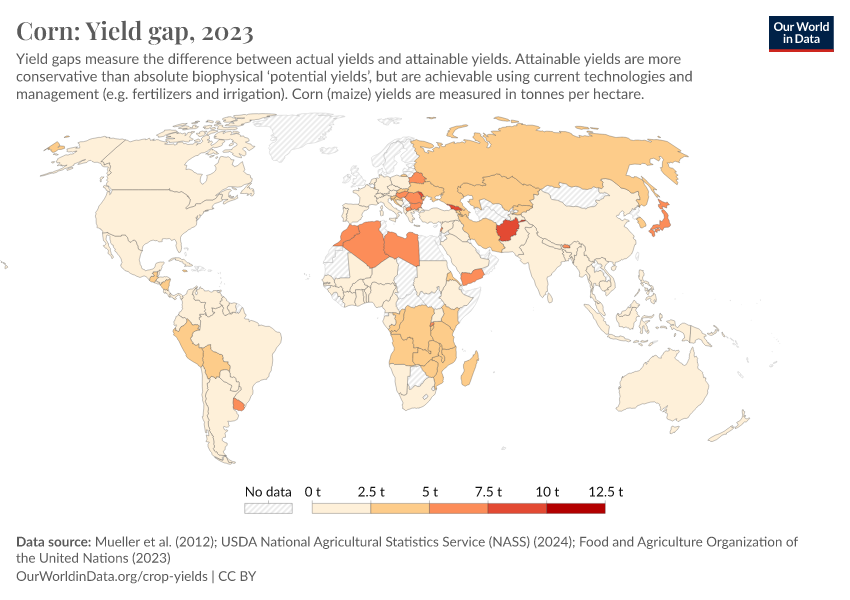Corn: Yield gap

What you should know about this indicator
- Attainable yields are estimates of feasible crop yields calculated from high-yielding areas of similar climate. Yields are measured in tonnes per hectare.
- Attainable yields are more conservative than biophysical 'potential yields', but should be achievable using current technologies and management (e.g. fertilizers and irrigation).
- Attainable yields are based on assessments for the year 2000. Real attainable yield pre-2000 may be lower; and post-2000 may be higher than these values.
What you should know about this indicator
- Attainable yields are estimates of feasible crop yields calculated from high-yielding areas of similar climate. Yields are measured in tonnes per hectare.
- Attainable yields are more conservative than biophysical 'potential yields', but should be achievable using current technologies and management (e.g. fertilizers and irrigation).
- Attainable yields are based on assessments for the year 2000. Real attainable yield pre-2000 may be lower; and post-2000 may be higher than these values.
Sources and processing
This data is based on the following sources
How we process data at Our World in Data
All data and visualizations on Our World in Data rely on data sourced from one or several original data providers. Preparing this original data involves several processing steps. Depending on the data, this can include standardizing country names and world region definitions, converting units, calculating derived indicators such as per capita measures, as well as adding or adapting metadata such as the name or the description given to an indicator.
At the link below you can find a detailed description of the structure of our data pipeline, including links to all the code used to prepare data across Our World in Data.
Notes on our processing step for this indicator
- Yield gaps have been calculated by Our World in Data as the attainable yields, as reported by Mueller et al. (2012), minus the actual observed yields, as reported by the UN FAO. Negative values have been clipped to zero, meaning that the attainable yield has been reached.
Reuse this work
- All data produced by third-party providers and made available by Our World in Data are subject to the license terms from the original providers. Our work would not be possible without the data providers we rely on, so we ask you to always cite them appropriately (see below). This is crucial to allow data providers to continue doing their work, enhancing, maintaining and updating valuable data.
- All data, visualizations, and code produced by Our World in Data are completely open access under the Creative Commons BY license. You have the permission to use, distribute, and reproduce these in any medium, provided the source and authors are credited.
Citations
How to cite this page
To cite this page overall, including any descriptions, FAQs or explanations of the data authored by Our World in Data, please use the following citation:
“Data Page: Corn: Yield gap”, part of the following publication: Hannah Ritchie, Pablo Rosado, and Max Roser (2022) - “Crop Yields”. Data adapted from Mueller et al., USDA National Agricultural Statistics Service (NASS), Food and Agriculture Organization of the United Nations. Retrieved from https://archive.ourworldindata.org/20250909-093708/grapher/maize-yield-gap.html [online resource] (archived on September 9, 2025).How to cite this data
In-line citationIf you have limited space (e.g. in data visualizations), you can use this abbreviated in-line citation:
Mueller et al. (2012); USDA National Agricultural Statistics Service (NASS) (2024); Food and Agriculture Organization of the United Nations (2025) – with major processing by Our World in DataFull citation
Mueller et al. (2012); USDA National Agricultural Statistics Service (NASS) (2024); Food and Agriculture Organization of the United Nations (2025) – with major processing by Our World in Data. “Corn: Yield gap” [dataset]. Mueller et al., “Closing yield gaps through nutrient and water management”; USDA National Agricultural Statistics Service (NASS), “Long-term corn yields in United States”; Food and Agriculture Organization of the United Nations, “Production: Crops and livestock products” [original data]. Retrieved January 4, 2026 from https://archive.ourworldindata.org/20250909-093708/grapher/maize-yield-gap.html (archived on September 9, 2025).